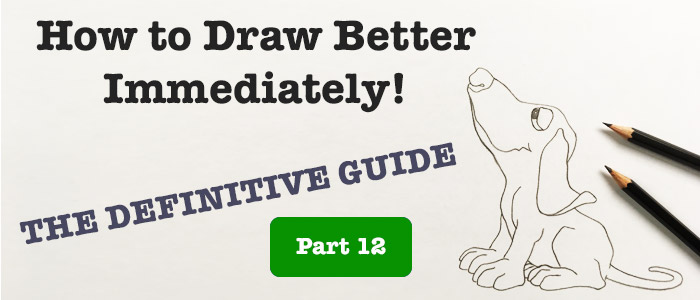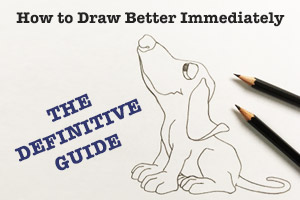
This is part 12 of the series How to Draw Better Immediately – The Definitive Guide.
Often, when you are comparing spaces it is necessary to compare the angles and sizes of shapes as well. It takes quite a bit of coordination to use all of these comparison skills at once! For this reason, it’s a great idea to concentrate on refining just one comparison skill at a time.
During the Complete Online Drawing Course, you will notice that this strategy is emphasised in the final section of the course, which is also when you begin to learn to compose original artworks.
The art of composing or creating an entirely original artwork from your own imagination requires that you understand where to place objects on the picture-plane, so that they appear pleasing to the viewer. This skill, fortunately, can be acquired over time. For some this skill comes more easily than for others, but with practice and experience, nearly anyone can grasp this.
It’s important to be patient with yourself during this process – you must resist the temptation to run before you can walk!
The Rules of Composition
The wonderful thing about this skill is that you can take guidance from the established rules of composition. As you become familiar with this broader skill of composition, you will find yourself creating artworks characterised by harmony, rhythm and balance. These rules are handed down from the great masters of art; but you don’t need to adhere to them rigidly. They simply exist as a helpful guide, informing your decisions about where to place objects in your artworks and helping you to understand the reasons behind this.
Here are some examples of questions and thoughts that you might pose to yourself whilst comparing spaces:
- “Does this cup look good in front of this teapot? Perhaps it should rather go behind it?”
- “Is the background space too empty? Should I add some little birds to break the monotony and make the space more interesting?”
- “What sorts of sizes are lacking from my composition? I already have some really big shapes and some medium ones – perhaps I need some really tiny ones as well? If so, how many?”
- “What’s the most important part of my drawing?”
- “What if I don’t include the stem of the flowers and instead place more leaves in here?”
- “Should I add a huge curve here for the other mountain, or just leave it out all together? What about two more over here instead?”
Here are some other kinds of statements that you might make to yourself:
- “This is the most important part of my image – one of my focal points. So I must make that area the brightest, with the greatest contrast and detail.”
- “This area is too large – it needs more finer details added for the sake of interest.”
- “I must make the background lighter to lead the viewer back into the picture plane.”
These examples are just a taste of the sort of thought process that you might have whilst composing totally original artworks. It’s an exhilarating journey: the process of bringing together all the skills that you have learned, in order to create an image totally from your imagination!


